Tourist Information
About Ghent
Ghent is the capital of East-Flanders and counts about 250,000 inhabitants. According to National Geographic Traveler Magazine, Ghent is the third city in its global ranking of most beautiful cities across the world. Ghent is a lively city with more than 70,000 University and University College students.
In what follows, we provide some tourist information about Ghent based on the official city website.
Castle of the Counts
"I'll show them who's boss": that is what Philip of Alsace had in mind. So he had the imposing castle rebuilt (1180). Overlooking the city from its battlements high up on the keep, one can sense the feeling of wealth and power that the lord of the castle must have had.
Click here for more information.
Beguinages
The Old St Elizabeth Beguinage is no longer walled. In 1874 it was replaced by the Great Beguinage in Sint-Amandsberg, just outside the city. The Small Beguinage, O.L.V. ter Hoyen dates back to 1235 and is one of the best preserved from before the French Revolution. Listed as UNESCO World Heritage Sites.
Click here for more information.
The Belfry
The Belfry is the proudest symbol of the city's independence. The Cloth Hall was built onto the side of the Belfry. In a euphoric Brabant Gothic style; this monument glorifies the industry to which the city owes so much. At the corner of the Cloth Hall is an old jailer's lodge. The facade is adorned with the 'Mammelokker' which depicts the legend of Cimon who was condemned to starve to death. He was saed by his daughter who fed him daily from her breast. The Belfry is the middle of the famous three-rower row, together with the Saint Bavo's Cathedral and the Saint Nicholas's Church.
Click here for more information.
Graslei and Korenlei
Ask ten inhabitants of Ghent what the most beautiful place in their city is and nine will answer the Graslei. Today this medieval port with its unique row of historical buildings, which are reflected in the long river, is the meeting place par excellence. Young and old, inhabitant and visitor, everyone meets on one of the many café patios or simply by the water. This is the thriving heart of the inner city.
Click here for more information.
Stam - Ghent City Museum
Ghent has something from every period of history and that also applies to the STAM: the 14th-century abbey, the 17th-century monastery and the new 21st-century development together form the Ghent City museum. Unmistakably contemporary against a unique historical background, the museum tells the story of Ghent through inspiring collection pieces and interactive multimedia. Past, present and future are illustrated in a clear and interesting trail, detailing Ghent's transformation from a medieval metropolis into a city of knowledge and culture.
Click here for more information.
St Bavo's Cathedral
When Charles V was baptised there in 1500, the metamorphosis from a closed Romaneque church to a spacious Gothic one was fully underway. However, despite substantial financial support from the emperor, the cathedral still remained unfinished 58 years later. All that remains of the original Romanesque church is the crypt. St. Bavo's athedral housed an impressive number of art treasures: the baroque high altar in white, black and red flamed marble, the rococo pulpit in oak, gilded wood and marble, a major work by Rubens, the Calvary Triptych, attributed to Joos van Wassenhove, alias Justus van Ghent, tombs of the Ghent bishops and much more. However, one work stands out head and shoulders above the rest: the world-famous Adoration of the Mystic Lamb painted by Hubert and Jan van Eyck around 1432.
Click here for more information.
